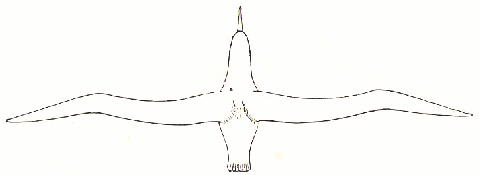|
The name Albatross derives from a corruption
of the Spanish and Portuguese
Alcatraz or
Alcaduz by which
name the Pelican is known in some parts of the Iberian peninsula and the
Spanish colonies in the West Indies (The word is Arabic, al-cadous,
adopted
from the Greek kados,
water-pot or bucket (cf. Dozy &
Engelmann, Glossaire des mots espagn. et portug. derives de l' Arabe,
ed.
2, p. 79), and especially signifying the leathern bucket of an irrigating
machine. Thence it was applied to the Pelican, from the resemblance of
that bird's pouch, in which it was believed to carry water to its young
in the wilderness.); but it is also applied vaguely to other large sea-birds.
By English navigators its use and definition was formerly quite as indiscriminate,
and its spelling no less so, the forms Alcatraza, Alcatraze, Algatross,
and Albitross, occurring in various authors-the last being that found in
Shelvocke's
Voyage
(London: 1726), wherein (pp. 72, 73) is recorded
the incident that, on Wordsworth's suggestion, Coleridge immortalized in
his Rime of the Ancient Mariner.
In process of time the name has
become limited to birds of the genus
Thalassarche, Phoebastria, Phoebetria,
and particularly
Diomedeidae,
a family of the group Tubinares,
and especially to the largest species of the genus, Diomedea exulans,
the "Man-of-war bird" or
Wandering Albatross.
Although the Wandering Albatross,
has been so long the observed of all observers among voyagers to the Southern
Ocean, even as recently as at the latter part of the 19th there had been
no one who seems to have had given, from life, its finished portrait on
the wing, and hardly such a description as would enable those who have
not seen it to form an idea of its look. The diagrammatic sketch by Captain
(later Professor) Hutton (born 1836, died 1905), shown here, is probably
a more the most accurate representation of it than could be found in the
conventional figures which abounded in books at that time.

Diagrammatic Picture of Albatross
Information about
the Flight of the Albatross
Writers who apply to
the Flight of the Wandering Albatross the epithets graceful, grand, majestic,
and the like, convey the bird's extremely characteristic appearance. The
ease with which it maintains itself in the air, "sailing" for a long while
without any perceptible motion of its wings, whether gliding over the billows,
or boldly shooting aloft again to descend and possibly alight on the surface,
has been dwelt upon often, as has its capacity to perform these feats equally
in a seeming calm or in the face of a gale. A most vivid description
is that of James Anthony Froude in his 1886 book,
Oceana,
pages
65-66, which was cited by Sir W. Buller (B. New Zeal.
ed. 2, ii.
p. 195). Mr Froude told of how The Albatross "wheels in circles round
and round, and for ever round the ship - now far behind, now sweeping past
in a long rapid curve, like a perfect skater on an untouched field of ice."
and tells of the almost effortless way that the bird flies near the water
with rarely a stroke of its wings, seeming to disappear between the high
and low waves, then rising above the waves' crests with a tiny adjustment
to the inclination of the wings which are usually parallel with the sea.
But when turning to rise or to change its direction, the wings can point
at such an angle that one aims at the sky whereas the other points to the
water.
Since those times, with the advent of modern
photography, film and video, both still and action pictures have shown
this feathered aeronaut with becoming dignity.
The mode in which the "sailing" of the
Albatross is effected has been much discussed, but Professor Hutton in
Ibis,
1865,
page 296 summarised what is now known as the "dynamic soaring" method that
this bird uses, in his description that it is "by combining, according
to the laws of mechanics, this pressure of the air against his wings with
the force of gravity, and by using his head and tail as bow and stern rudders,
that the Albatross is enabled to sail in any direction he pleases, so long
as his momentum lasts."
|





